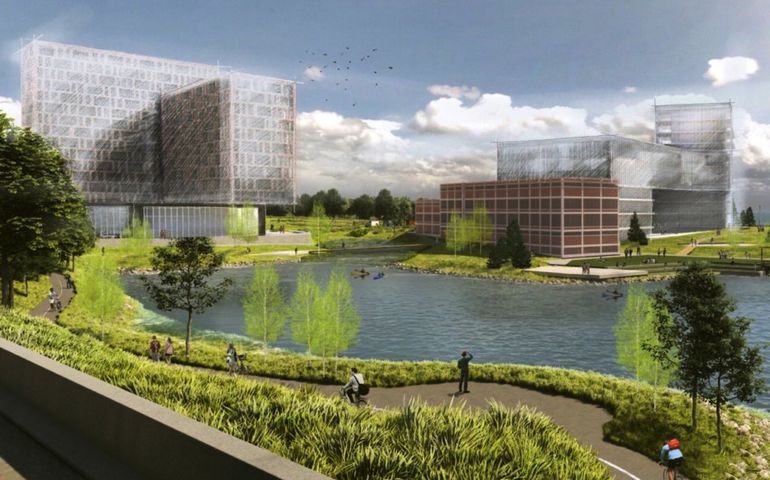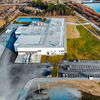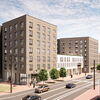Processing Your Payment
Please do not leave this page until complete. This can take a few moments.
- News
-
Editions
View Digital Editions
Biweekly Issues
- December 15, 2025
- December 1, 2025
- Nov. 17, 2025
- November 03, 2025
- October 20, 2025
- October 6, 2025
- + More
Special Editions
- Lists
- Viewpoints
-
Our Events
Event Info
Award Honorees
- Calendar
- Biz Marketplace
B&M site wasn't for sale — until the right buyer came along
 COURTESY / Tsoi Kobus Design
A rendering shows the Roux Institute's proposed campus at the former B&M site in Portland.
COURTESY / Tsoi Kobus Design
A rendering shows the Roux Institute's proposed campus at the former B&M site in Portland.
A century-old building that was never up for sale was acquired to become a new campus that will house the the Roux Institute at Northeastern University, ideally for another century.
The B&M baked bean manufacturing plant, which has been a stalwart icon at the edge of the city for generations, will now become home to new technologies such as artificial intelligence.
Buying something that’s not for sale takes a little creativity and long-lasting relationships.
Tony McDonald, a partner at the Boulos Co., served as an advisor for the nonprofit Institute for Digital Engineering and Life Sciences (IDEALS) in its site search for a new campus for the Roux Institute at Northeastern University.
The 13.5-acre site will host classrooms, laboratory space, offices, partner companies, housing, a hotel, retail, restaurants and a coastal water restoration effort. The B&M manufacturing building is expected to be converted to an incubator lab, office and manufacturing space for startups.
“We are confident the Roux Institute will build a new longstanding legacy on the property, one that will enrich Portland residents in new and exciting ways and will endure as a force for good in the community for generations to come,” said Casey Keller, president and CEO of B&G Foods, owner of B&M.
Charles E. Hewett, executive director of IDEALS, said “we looked seriously at a lot of sites, made offers on several, but encountered owners who were really only in it for their own gain.”
“B&G Foods saw what the property could mean for the future of Portland, were clear from the outset on what deal terms they would need, and though they drove a tough bargain, they were honorable and pleasant to work with,” Hewett said.
The B&M location was not on the initial list of potential locations for Roux, McDonald said.
A laundry list of needs
IDEALS, which had looked on its own initially before hiring McDonald, had a laundry list of things it was seeking: at least 150,000 square feet of classroom and laboratory space, up to 125,000 square feet of office space, 100,000 square feet of residential space, among other things. It needed room to grow with the possibility of a parking area that could be built over at a later time for additional building space if parking needs eased.
“Even in the most dense zoning areas, you might find three or four acres,” McDonald said. “There’s not many parcels that can handle this much need. It starts the whittling down process.”
McDonald said IDEALS looked all over Greater Portland and focused on a few sites on the Portland peninsula and in other communities such as South Portland and Westbrook. He declined to identify the short list of candidates, but said they considered “a lot of usual suspects.”
“We wanted to own and some sites didn’t want to sell, just lease. We needed to own it. We were inflexible about that,” McDonald said.
IDEALS had a “few false starts” that it pursued but each site faltered because of the ownership need, McDonald said. IDEALS wanted to own so it could hand Northeastern an asset that would grow over time and not be hampered by a landlord or lease constraints.
Artificial intelligence and other Roux technology fields could be done anywhere, but Roux chose to do them in Portland. IDEALS studied population trends, looked at where Portland is going and growing.
“They see Portland going in a very positive direction. They want Roux to thrive in the community and build up the community. Those types of things happen in very few places in the U.S.,” McDonald said.
IDEALS and Roux “had a commitment to do it here. It wasn’t a competition with other locations around the country. They were very patient to wait for the right deal,” McDonald said.
Meanwhile, Northeastern gave a perspective on space and growth. It has run a university that has grown over time and has become space-constrained.
“Northeastern brought a great perspective on a 50-, 100-, 150-, 200-year horizon for growth that we needed to be thinking about. That was very different for me. I’m usually thinking about a professional services firm looking at a five-year lease,” McDonald said.
To find the right space, McDonald stopped looking at properties that were up for sale or quietly looking for buyers. Instead, he went back to basics and began looking at Google Earth aerial views of Portland just to see where Roux might actually fit.
“Forget about who owns it, was it for sale or not. I just started looking for what Roux wanted: aesthetically pleasing, close to downtown and easy to get in and out of. That’s when I realized it was B&M,” McDonald said.
To get the deal done, McDonald relied on his history with B&M, which he had been in contact with for about a decade.
B&M had looked at possibly relocating 10 to 15 years ago, he said. Then the St. Lawrence & Atlantic Railroad stopped delivering beans by rail in 2015 and instead the beans needed to be delivered by truck, which added to costs.
“It was about 10-plus years of staying in touch with them from time to time that I knew things weren’t perfect for them,” McDonald said. “I knew from talking to them for years that there were other ways to make baked beans. I knew other options existed for them. When we came along, it may have rekindled those thoughts.”
B&M’s parent, B&G Foods, was “intrigued, supportive and receptive” at IDEALS initial inquiry, but made it clear that “it wasn’t for sale, wasn’t available or anything,” McDonald said. “They were unwilling to get into discussions. But we did our homework and said ‘we’re ready to move to contract,’ and then it moved quickly,” McDonald said.
The B&M site was close to downtown, but avoided many of the pitfalls of downtown like traffic and parking constraints, McDonald said. The site quickly checked a lot of boxes such as convenience to downtown, 13.5 acres, visibility and a stunning location with a marina as a neighbor, McDonald said. About 8 acres is viable to build on.
A deal comes together
The B&M deal came together in a matter of months. IDEALS did quick but thorough due diligence. The environmental review showed no real issues.
“Once B&G realized we were serious, it became a relatively quick transaction,” McDonald said.
Terms of the deal were not disclosed.
IDEALS did not ask the city of Portland for any assistance or financial help.
“It’s a pretty unique project. It was very well funded, well directed and wasn’t seeking public assistance,” McDonald said.
“It’s a site for the ages. Roux can work with that space for a long-term solution for its growth,” McDonald said. “Other locations might have been OK for 10, 20, 30 years but we might grow out of them by then.”
Hewett added: “We were looking for an iconic location to establish a Maine legacy of innovative high tech and biopharma excellence to underpin the excellent work that the Roux Institute and its partners were already doing. We found it.”
Mainebiz web partners
What a wonderful opportunity to take a historic site and turn it into a great learning environment. Unfortunately the Roux Institute's envisioned project, looks a sight. A couple of unattractive, gigantic buildings on the Portland waterfront is not what is needed. An attractive lower complex should be envisioned, not the eye sore that is shown. Hopefully, materials and aesthetics will be mindfully used to keep this area from looking like a glass and concrete albatross.

The Giving Guide
The Giving Guide helps nonprofits have the opportunity to showcase and differentiate their organizations so that businesses better understand how they can contribute to a nonprofit’s mission and work.
Learn More
Work for ME
Work for ME is a workforce development tool to help Maine’s employers target Maine’s emerging workforce. Work for ME highlights each industry, its impact on Maine’s economy, the jobs available to entry-level workers, the training and education needed to get a career started.
Learn More
Groundbreaking Maine
Whether you’re a developer, financer, architect, or industry enthusiast, Groundbreaking Maine is crafted to be your go-to source for valuable insights in Maine’s real estate and construction community.
Learn more-
The Giving Guide
The Giving Guide helps nonprofits have the opportunity to showcase and differentiate their organizations so that businesses better understand how they can contribute to a nonprofit’s mission and work.
-
Work for ME
Work for ME is a workforce development tool to help Maine’s employers target Maine’s emerging workforce. Work for ME highlights each industry, its impact on Maine’s economy, the jobs available to entry-level workers, the training and education needed to get a career started.
-
Groundbreaking Maine
Whether you’re a developer, financer, architect, or industry enthusiast, Groundbreaking Maine is crafted to be your go-to source for valuable insights in Maine’s real estate and construction community.
ABOUT
NEW ENGLAND BUSINESS MEDIA SITES
No articles left
Get access now
In order to use this feature, we need some information from you. You can also login or register for a free account.
By clicking submit you are agreeing to our cookie usage and Privacy Policy
Already have an account? Login
Already have an account? Login
Want to create an account? Register
Get access now
In order to use this feature, we need some information from you. You can also login or register for a free account.
By clicking submit you are agreeing to our cookie usage and Privacy Policy
Already have an account? Login
Already have an account? Login
Want to create an account? Register







1 Comments